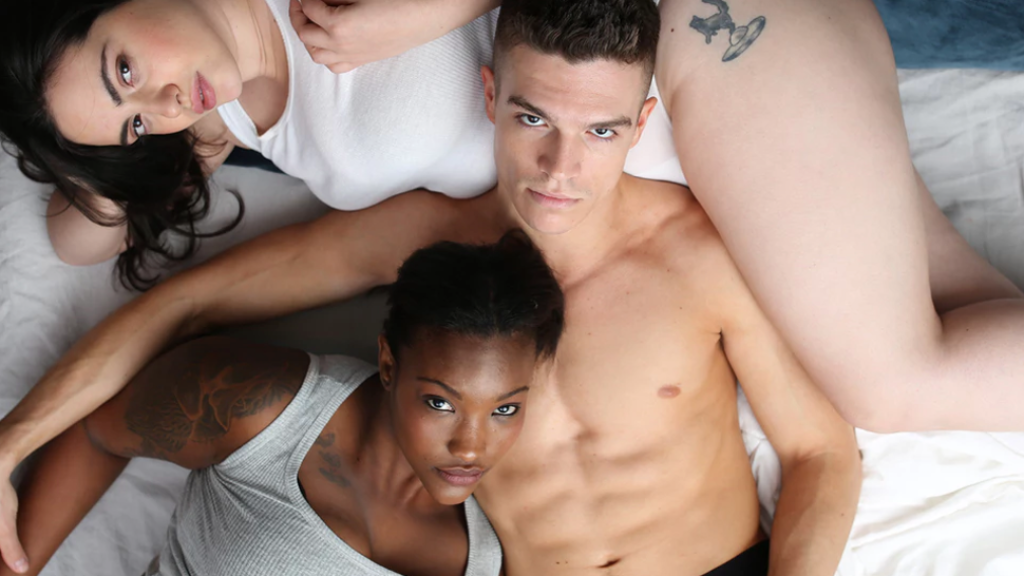SEXUAL WANDERLUST
Monogamy Isn't A Type Of Exotic Wood


During a recent vacation in Mexico, I saw a young, good-looking couple arrive at the hotel pool. As the cabana boy set up their lounges, I observed their playful, sexually-charged interaction and presumed they were on their honeymoon. When a second woman joined them, taking her place next to the newly-wed husband, I revised my deduction – I figured she must be a friend who was tagging along on the couple’s vacation. That was until the bride went for a swim and the second woman started canoodling with the groom. I looked around to see if anyone else had noticed their blatant infidelity, but it appeared that I, alone, had witnessed their titillating imprudence.
That night, as I made my way back to my room, I spotted the three of them in the moonlit jacuzzi. It was clear that what I had witnessed earlier wasn’t just a moment of illicit indiscretion, but rather, the unabashed behavior of a modern-day ménage a trois.

Like Gustav von Aschenbach, the protagonist in Death in Venice, I became obsessed with the trio and over the next few days, continued to observe them as if they were the subjects of a sociological study or the cast of a reality TV show. I was struck by how open they were about their unconventional lifestyle and was intrigued because I knew I could never be so free. Like many of my generation, I had dabbled in Quaalude-fueled orgies during high school and a three-way here and there, but truth be told, I never liked sharing, not even at a Chinese restaurant. What’s mine is mine and I want it that way.
I assumed that most people felt the same way, but when I returned home from vacation, a friend called to tell me about the “Smoking hot weekend” he and his boyfriend had spent with a 24-year-old twinkie they met online. Then I remembered a business associate telling me that he and his wife of 16 years had taken in a 23-year-old third and were now living happily as a throuple.

Was I in the minority? Had I slept through the polyamorous revolution? Can we romantically love more than one person at a time? Reading up on the subject, I soon discovered that non-monogamous relationships, defined as open and consensual, aren’t only the stuff of French sex comedies and the harems in One Thousand and One Arabian Nights. Swinging, polyfidelity, polyamory, polygamy, thruples, open relationships, sexual anarchy, triads, quads and cross-coupling are all part of the non-monogamy movement that, along with sites like Tinder, Scruff, Grindr and Zoosk, is changing the face of modern relationships.
According to a 2016 study in The Journal of Sex and Marital Therapy, 4%-5% of adults in the United States are participating in some form of a consensual non-monogamous relationship. That’s 10 to 12 million people! A YouGov study found that 49% of people under 30 reported that their ideal relationship would be non-monogamous. A 2017 Match survey showed that 62% of singles in America said they approve of polyamory and an eye-opening 39% of straight singles are interested in having a three-way with someone of their gender, fulfilling a lot of people’s fantasies and putting the triad from the hotel in Mexico in some sort of context. When the American Psychological Association created a task force on consensual non-monogamy to encourage understanding of non-traditional relationship structures, it became clear that something is happening in the evolution of liaisons.
So, who are the people casting traditional relationships to the wind? According to a 2012 study on open relationships, non-consensual non-monogamy and monogamy conducted by the National Institutes of Health, they are a diverse group. When it comes to consensual open relationships, they are 2% heterosexual, 32% gay, 5% lesbian, 22% bisexual and 14% individuals who described their sexual identity as “other.” Looking at non-consensual non-monogamy, i.e., cheating, they are 8% heterosexual, 14% gay, 6% lesbian, 18% bisexual and 6% other. Based on these findings, it appears that heterosexuals and lesbians are less likely to be open with their primary partners about their desire to partake in non-monogamous behavior than those who identify as gay, bisexual and “other.”

In a paper published in the Journal of Sex and Research, Dr. Rhonda Balzarini of the University of Western Ontario found that women are more comfortable with the idea of polyamorous relationships than men, contradicting Dorothy Parker, whose octave, General Review of the Sex Situation maintains:
Woman wants monogamy;
Man delights in novelty.
Love is woman’s moon and sun;
Man has other forms of fun.
Woman lives but in her lord;
Count to ten, and man is bored.
With this the gist and sum of it,
What earthly good can come of it?
So, are practitioners of non-monogamy happier than the rest of us? Apparently not. According to the NIH study, individuals in open and/or non-consensual non-monogamy relationships reported lower levels of overall happiness in their primary relationships than monogamous participants. In summary, sexual wanderlust could be just that – a longing for wandering, but I’ve got to tell you, that trio in Mexico looked pretty happy to me.
